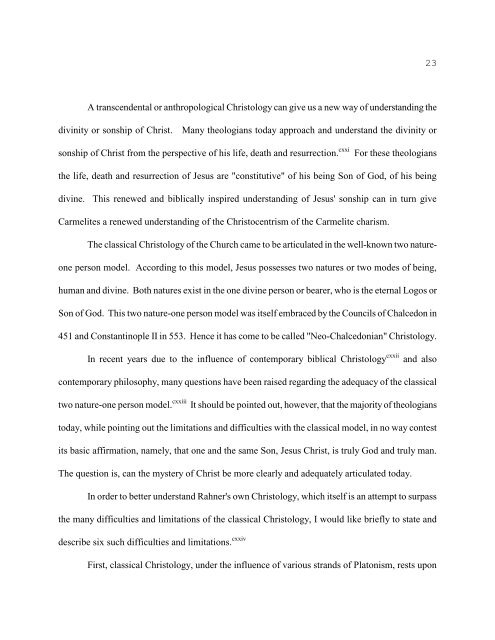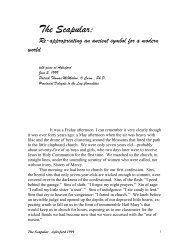Christocentrism of Charism – Buggert - CarmelStream
Christocentrism of Charism – Buggert - CarmelStream
Christocentrism of Charism – Buggert - CarmelStream
You also want an ePaper? Increase the reach of your titles
YUMPU automatically turns print PDFs into web optimized ePapers that Google loves.
A transcendental or anthropological Christology can give us a new way <strong>of</strong> understanding the<br />
divinity or sonship <strong>of</strong> Christ. Many theologians today approach and understand the divinity or<br />
sonship <strong>of</strong> Christ from the perspective <strong>of</strong> his life, death and resurrection. cxxi For these theologians<br />
the life, death and resurrection <strong>of</strong> Jesus are "constitutive" <strong>of</strong> his being Son <strong>of</strong> God, <strong>of</strong> his being<br />
divine. This renewed and biblically inspired understanding <strong>of</strong> Jesus' sonship can in turn give<br />
Carmelites a renewed understanding <strong>of</strong> the <strong>Christocentrism</strong> <strong>of</strong> the Carmelite charism.<br />
The classical Christology <strong>of</strong> the Church came to be articulated in the well-known two nature-<br />
one person model. According to this model, Jesus possesses two natures or two modes <strong>of</strong> being,<br />
human and divine. Both natures exist in the one divine person or bearer, who is the eternal Logos or<br />
Son <strong>of</strong> God. This two nature-one person model was itself embraced by the Councils <strong>of</strong> Chalcedon in<br />
451 and Constantinople II in 553. Hence it has come to be called "Neo-Chalcedonian" Christology.<br />
In recent years due to the influence <strong>of</strong> contemporary biblical Christology cxxii and also<br />
contemporary philosophy, many questions have been raised regarding the adequacy <strong>of</strong> the classical<br />
two nature-one person model. cxxiii It should be pointed out, however, that the majority <strong>of</strong> theologians<br />
today, while pointing out the limitations and difficulties with the classical model, in no way contest<br />
its basic affirmation, namely, that one and the same Son, Jesus Christ, is truly God and truly man.<br />
The question is, can the mystery <strong>of</strong> Christ be more clearly and adequately articulated today.<br />
In order to better understand Rahner's own Christology, which itself is an attempt to surpass<br />
the many difficulties and limitations <strong>of</strong> the classical Christology, I would like briefly to state and<br />
describe six such difficulties and limitations. cxxiv<br />
First, classical Christology, under the influence <strong>of</strong> various strands <strong>of</strong> Platonism, rests upon<br />
23



